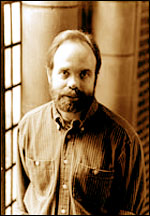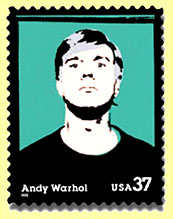Warhol Quotes:
"If you want to know all about Andy Warhol,
just look at the surface of my paintings and films and me,
and there I am. There's nothing behind it."
"The reason I'm painting this way is that I want to be a machine,
and I feel that whatever I do and do machine-like is what I want to do."
"I like boring things. I like things to be exactly the same over and over again."
"I don't want it to be essentially the same— I want it to be exactly the same.
Because the more you look at the same exact thing, the more the meaning goes away,
and the better and emptier you feel."
"I'd prefer to remain a mystery. I never like to give my background
and, anyway, I make it all up different every time I'm asked."
"In the future everybody will be world famous for fifteen minutes."
****************************************************************
.jpg)
Jackie (1964) |
.jpg)
Marilyn (1963) |
.jpg)
Liz (1964) |
Slides Shown During Crow's Lecture:
Crow began his lecture with a Warhol quote:
"If you want to know all about Andy Warhol,
just look at the surface of my paintings and films
and me, and there I am. There's nothing behind it."
1) Andy Warhol with sunglasses reclining on a sofa (B&W)
2) Andy Warhol in a meditative pose (color photo)
3) Warhol eyes closed at a microphone
4) Warhol with sunglasses looking at his silk screens
Christopher Knight, art critic had a lead article in the LA Times:
"Andy Warhol made Imelda Marcos look like Mother Teresa." (1997)
5) Movie stars posters mounted sideways
6) Bonwit Teller window display with Warhol theme
Knight: "Warhol slayed European art."
Paul Mandel: "Rather than to justify... celebrated popular culture
matched by an euphoric... business joined with creativity.
at a reading of Warhol's paintings (1983).
This body of Warhol's paintings is called "Painting-Noir"
7) Ambulance Disaster (1963) [Plate 261]
8) Black and White Disaster (1962) [Plate 268]
9) Saturday Disaster (1964) [Plate 271]
10) Automobile accident photo collage
Warhol merged art with art culture
Why bother to look at Warhol's art at all?
Tate Modern and MOCA Warhol Exhibit last year brought out lots of
young people to the art museums. A younger generation feels that
Warhol still matters. Last week, film scholar Mike Segal said:
"Warhol is not just a 1960's counter-culture scene. Otherwise,
it prohibits our understanding of Warhol's work in the 1960's"
In the mayhem and death pictures— Warhol had access to wire
photos of violent scenes not even published in the press.
11) Avant-garde photos of the modern dancer Merce Cunningham (11 photos)
12) Painting based on the Cunningham photos (15 scenes) (Oct. 1962) [Plate 323]
Lamont Young's sustained tone
[Lamont Young's magnum opus is The Well Tuned Piano, a large work in many
parts began in 1964 to which he keeps adding pieces. Special tuning based on just
intonation (pure fifths). Worked with Andy Warhol and the Velvet Undergraound.]
conventional norm, aesthetic devices not 20th century
the sub-popular, anti-popular culture
My contribution to this Warholian world— as if reconstructing lost civilization
What is the defining epic? What are the main characteristics?
Who lives in this world? The main character is a woman.
the golden hair woman— Marilyn
but also the raven hair woman— Liz
and the innocent woman— Jackie
13)
Shot Sage Blue Marilyn (1964)
14)
Dame Elizabeth Taylor (1967) offset lithograph
15)
Red Jackie
16) Round Jackie Diptych (right side empty)
17)
Marilyn Diptych (1962)
[Collection of Mr. and Mrs. Burton Tremaine, Meriden, Conn.]
Woman is emblazonized guise that's unrecognizable.
18) Mona Lisa (1963) [Plate 238]
19) Liz Taylor as Cleopatra
Warhol uses pop-culture for his work:
20)
32 Campbell Soup Cans (1962) [Plate 164]
as well as disaster newsclippings as source of his work.
21)
Tunafish Disaster (1963) [Plates 269-270]
He could be whimsical as the following synthetic polymer paint on canvas:
22)
Dance Diagram (1962) [Plate 163]
23)
Do It Yourself (Landscape) (1962) [Plate 159]
Marlon Brando (1966)
(Description)
20 Jackies (1964)
(Crow: The woman mourns for her King)
Flowers
(Description)
Andy Warhol and Edie Sedgwick
(Crow: This is a very touching photo)
SLIDE
(Description)
SLIDE
(Description)
********************************************
Q & A Session (4:50 pm)
| Q: |
Why we elevate Warhol to such heights when he didn't do original images himself? |
| A: |
That's what the whole talk is all about!
Allegory is devalued now— need to be recycled (reference to
Jeff Koons)
Intuitive answer— observe people and the images that have a grip on us.
What is that power? Artists aren't original, they're mechanical.
I descry the allegorical mode. Respect other people's observations.
Emotive projection of outer manifestation (symbols fail?)
|
| Q: |
Why use allegory when the modern public can't understand it?
During the Middle Ages, the readership knows the symbolic lexicon. |
| A: |
The first level is clarity— code to get the message.
The second level is enigma or mystery that is attached to allegory.
Allegory in historical context is difficult to figure out.
Warhol used common images but the public didn't look at them artistically.
Warhol guides his viewers imaginatively. |
| Q: |
I'm not an art student. Monet's Waterlilies are repetitions in the 19th century.
Warhol's repetitions of public images-- material world of his urbanity--
suggests global insanity |
| A: |
You said so much! compare the secularism in 19th century France. |
| Q: |
Walter Benjamin's allegory— tragic, deathly distant ruin |
| A: |
That's the famous interpretation of allegory in the 1970s.
German tragic drama (mainly plays, Craig Owen?)
I don't understand Benjamin's examples.
Rather look at examples I understand.
I find Angus Fletcher
and
C.S. Lewis more instructive. |
| Q: |
Has there been a backlash to abstract expressionism? Jungian archetype? |
| A: |
Solitary search for balance within one's psyche. Even Jackson Pollack
never turned it into painting the terrible extremes of suicide.
Warhol gives us a grip on modernity. |
| Q: |
I was struck with your parallel between Andy Warhol and Bob Dylan.
Is allegory making a return? |
| A: |
Wholeness becomes a trap rather than fragmentation.
High-minded exclusion of the banal. Visual arts begins with
Rauschenberg (1954)
Natural objects for sculpture and paintings. |
| Q: |
How did Rauschenberg influence Warhol? |
| A: |
Rauschenberg interested in
found things— "arrested flight"
strict motifs put together, Narcissus falling into the pool.
In 1962, Warhol got his wings from Rauschenberg's art.
Warhol did Let Us Now Praise Famous Men [(Rauschenberg Family) in 1963]
[Note: Walker Evans photographed sharecroppers in Alabama in 1936 while
James Agee wrote the text (1938). Their book
Let Us Now Praise Famous Men
was published in 1941. Warhol's paid tribute to Robert Rauschenberg & his family
in a silkscreen ink on canvas of the same title (1963).
Andy Warhol: A Retrospective (1989), plate 226] |
********************************************
Books by Thomas Crow: (at Amazon.com)
Web Links to Thomas Crow
•
Prof. Thomas Crow (Director, Getty Research Institute at the Getty Center, Los Angeles
and Professor of Art History at the University of Southern California.)
•
Thomas Crow Named Director of Getty Research Institute
Renowned Yale University Art Historian Returns to Southern California
(Getty Press Release: February 14, 2000)
•
Marx to Sharks: Thomas Crow on the Art-Historical '80s
(Art Forum, April 2003)
•
Thomas Crow: The Unknown Conversation: The Last Works of Mark Rothko and Eva Hesse
(Mary Craig Auditorium, University of California-Santa Barbara, November 15, 2002)
•
Thomas Crow: The Marginal Difference in Rothko¹s Abstraction
(Phyllis Wattis Theater, SFMOMA Wattis Lecture Series, May 24, 2001)
•
Thomas Crow: The Intelligence of Art
(Radio: Arts Today with Michael Cathcart, Wednesday 8/11/00)
•
The Death of Glamour: Marilyn Monroe; Marilyn Diptych and Gold Marilyn
[Thomas Crow: "Saturday Disasters: Trace and Reference in early Warhol",
Art in America (May 1987)]
•
BOOK REVIEW: Thomas Crow's Modern Art in the Common Culture
(Yale University Press, 1996)
•
The Salon and David's Oath of the Horatii
(from Thomas Crow, Painters and Public Life in Eighteenth-Century Paris)
•
Contemporary Challenges to Traditional Categories of Analysis in the Humanities:
The Margins and the Centers,
ACLS Conference on the Humanities in the 1990s
(By Thomas Crow, University of Michigan, Ann Arbor, 1989)
Books about Andy Warhol: (at Amazon.com)
 |
• Andy Warhol,
The Philosophy of Andy Warhol, Harvest Books, (June 1988)
• Pat Hackett (Ed.),
Andy Warhol Diaries
Warner Books, Reprint edition (January 1991)
• Andy Warhol & Pat Hackett,
POPism: The Warhol Sixties
Harvest Books, Reissue edition (May 1990)
• Andy Warhol & Declan McGonagle,
After the Party: Andy Warhol Works, 1956-1986
Lund Humphries Pub Ltd; (February 1998)
• Victor Bockris,
Warhol, DaCapo Press; Reprint edition (October 1997)
• Jean Stein & George Plimpton (Ed.),
Edie: American Girl
Grove Press, (November 1994)
|
Web Links on Andy Warhol:
Andy Warhol Online
(Museums & Art Galleries, Biographies, Image Galleries, Web Links, Articles)
The Andy Warhol Homepage
(Biography, Books, Covers, Entourage, FAQ, Gallery, Links, Lyrics, Movies)
The Andy Warhol Museum
(117 Sandusky St., Pittsburgh, PA)
The Andy Warhol Foundation
(65 Bleecker Street, Floor 7, New York, NY, 10012)
PBS: AMERICAN MASTERS: Andy Warhol
(By, Feb. 11, 2003)
Andy Warhol Biography
(Brain-Juice biography with links to his art works)
Andy Warhol Timeline: 1928-1987
(Tate Modern Warhol Exhibit, Feb. 7-April 1, 2002)
* ART: Everything About Warhol but the Sex
(By HOLLAND COTTER, July 14, 2002)
* ART: A Warhol Retrospective Comes to Los Angeles
(By BERNARD WEINRAUB, May 23, 2002)
ANDY WARHOL RETROSPECTIVE
(Museum of Contemporary Art, Los Angeles, May 25-Aug. 18, 2002)
* WARHOL'S TRIUMPH: Putting the Pop artist in perspective
(By PETER SCHJELDAHL, The New Yorker, March 11, 2002)
Accident & Design [Review of Tate Modern Warhol Exhibit]
(Socialism Today, Issue 63, March 2002)
Twenty Jackies, Andy Warhol (1964)
(By Jonathan Jones, The Guardian, February 9, 2002)
Much More Than Fifteen Minutes
(By Tyler Maroney, Art News, January 2002)
Warhol revealed as passionate commentator
(By Kathleen KochCNN, January 2, 2001)
Andy Warhol's Brillo Box in Big Whitney Farce
(By Hilton Kramer, The New York Observer, Oct. 11, 1999)
Andy Warhol: A Salesman or an Artist?
(Samples of Warhol's Pop Art)
"POP ART'S KING DIES" (Andy Warhol, 1928-1987)
(NY Daily News, February 23, 1987)
Andy Warhol. Outer and Inner Space
(1965, 16mm film, B&W, sound, 0:33 min. in double screen, with Edie Sedgwick)
Andy Warhol and Autism
(By Ian Stewart)
Painters Painting— A Candid History of the Modern Art Scene, 1940 -197
(Henry Geldzahler meeting Andy Warhol in the early 1960s & recognized his genius)
Andy Warhol Velvet Underground
(gained notoriety as part of the Warhol circus in 1965)
2002 Andy Warhol U.S. 37¢ Postage Stamp
(Issued on August 9, 2002, Pittsburgh, Pennsylvania)
1996 Slovak Stamp: Andy Warhol Queen Ntombi Twalas
(1985 serigraph, The Warhol Family Museum of Modern Art, Medzilaborce)
WHAT THEY WERE THINKING: Baby Jane Holzer, Warhol's Factory
(Interview by Catherine Saint Louis, NY Times, Apr. 27, 2003)
![]()
![]()



.jpg)
.jpg)
.jpg)

